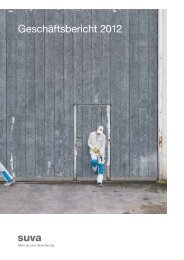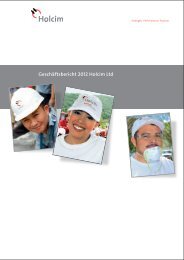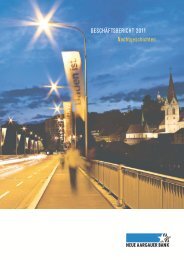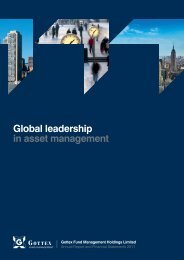Transocean Proxy Statement and 2010 Annual Report
Transocean Proxy Statement and 2010 Annual Report
Transocean Proxy Statement and 2010 Annual Report
You also want an ePaper? Increase the reach of your titles
YUMPU automatically turns print PDFs into web optimized ePapers that Google loves.
exposure to asbestos allegedly contained in drilling mud during these plaintiffs’ employment in drilling activities between 1965 <strong>and</strong> 1986. A<br />
Special Master, appointed to administer these cases pre-trial, subsequently required that each individual plaintiff file a separate lawsuit,<br />
<strong>and</strong> the original 21 multi-plaintiff complaints were then dismissed by the Circuit Courts. The amended complaints resulted in one of our<br />
subsidiaries being named as a direct defendant in seven cases. We have or may have an indirect interest in an additional 12 cases. The<br />
complaints generally allege that the defendants used or manufactured asbestos-containing products in connection with drilling operations<br />
<strong>and</strong> have included allegations of negligence, products liability, strict liability <strong>and</strong> claims allowed under the Jones Act <strong>and</strong> general maritime<br />
law. The plaintiffs generally seek awards of unspecified compensatory <strong>and</strong> punitive damages. In each of these cases, the complaints<br />
have named other unaffiliated defendant companies, including companies that allegedly manufactured the drilling-related products that<br />
contained asbestos. The preliminary information available on these claims is not sufficient to determine if there is an identifiable period for<br />
alleged exposure to asbestos, whether any asbestos exposure in fact occurred, the vessels potentially involved in the claims, or the basis<br />
on which the plaintiffs would support claims that their injuries were related to exposure to asbestos. However, the initial evidence available<br />
would suggest that we would have significant defenses to liability <strong>and</strong> damages. In 2009, two cases that were part of the original 2004<br />
multi-plaintiff suits went to trial in Mississippi against unaffiliated defendant companies which allegedly manufactured drilling-related<br />
products containing asbestos. We were not a defendant in either of these cases. One of the cases resulted in a substantial jury verdict in<br />
favor of the plaintiff, <strong>and</strong> this verdict was subsequently vacated by the trial judge on the basis that the plaintiff failed to meet its burden of<br />
proof. While the court’s decision is consistent with our general evaluation of the strength of these cases, it has not been reviewed on<br />
appeal. The second case resulted in a verdict completely in favor of the defendants. There were two additional trials in <strong>2010</strong>, one<br />
resulting in a substantial verdict for the plaintiff <strong>and</strong> one resulting in a complete verdict for the defendants. We were not a defendant in<br />
either case <strong>and</strong> both of the matters are currently on appeal. We intend to defend these lawsuits vigorously, although there can be no<br />
assurance as to the ultimate outcome. We historically have maintained broad liability insurance, although we are not certain whether<br />
insurance will cover the liabilities, if any, arising out of these claims. Based on our evaluation of the exposure to date, we do not expect the<br />
liability, if any, resulting from these claims to have a material adverse effect on our consolidated statement of financial position, results of<br />
operations or cash flows.<br />
One of our subsidiaries was involved in lawsuits arising out of the subsidiary’s involvement in the design, construction <strong>and</strong><br />
refurbishment of major industrial complexes. The operating assets of the subsidiary were sold <strong>and</strong> its operations discontinued in 1989,<br />
<strong>and</strong> the subsidiary has no remaining assets other than the insurance policies involved in its litigation, with its insurers <strong>and</strong>, either directly or<br />
indirectly as the beneficiary of a qualified settlement fund, funding from settlements with insurers, assigned rights from insurers <strong>and</strong><br />
“coverage-in-place” settlement agreements with insurers, <strong>and</strong> funds received from the communication of certain insurance policies. The<br />
subsidiary has been named as a defendant, along with numerous other companies, in lawsuits alleging bodily injury or personal injury as a<br />
result of exposure to asbestos. As of December 31, <strong>2010</strong>, the subsidiary was a defendant in approximately 1,037 lawsuits. Some of these<br />
lawsuits include multiple plaintiffs <strong>and</strong> we estimate that there are approximately 2,440 plaintiffs in these lawsuits. For many of these<br />
lawsuits, we have not been provided with sufficient information from the plaintiffs to determine whether all or some of the plaintiffs have<br />
claims against the subsidiary, the basis of any such claims, or the nature of their alleged injuries. The first of the asbestos-related lawsuits<br />
was filed against this subsidiary in 1990. Through December 31, <strong>2010</strong>, the amounts expended to resolve claims, including both defense<br />
fees <strong>and</strong> expenses <strong>and</strong> settlement costs, have not been material, all known deductibles have been satisfied or are inapplicable, <strong>and</strong> the<br />
subsidiary’s defense fees <strong>and</strong> expenses <strong>and</strong> costs of settlement have been met by insurance made available to the subsidiary. The<br />
subsidiary continues to be named as a defendant in additional lawsuits, <strong>and</strong> we cannot predict the number of additional cases in which it<br />
may be named a defendant nor can we predict the potential costs to resolve such additional cases or to resolve the pending cases.<br />
However, the subsidiary has in excess of $1 billion in insurance limits potentially available to the subsidiary. Although not all of the policies<br />
may be fully available due to the insolvency of certain insurers, we believe that the subsidiary will have sufficient funding from settlements<br />
<strong>and</strong> claims payments from insurers, assigned rights from insurers <strong>and</strong> “coverage-in-place” settlement agreements with insurers to respond<br />
to these claims. While we cannot predict or provide assurance as to the final outcome of these matters, we do not believe that the current<br />
value of the claims where we have been identified will have a material impact on our consolidated statement of financial position, results of<br />
operations or cash flows.<br />
Rio de Janeiro tax assessment—In the third quarter of 2006, we received tax assessments of approximately $188 million from<br />
the state tax authorities of Rio de Janeiro in Brazil against one of our Brazilian subsidiaries for taxes on equipment imported into the state<br />
in connection with our operations. The assessments resulted from a preliminary finding by these authorities that our subsidiary’s record<br />
keeping practices were deficient. We currently believe that the substantial majority of these assessments are without merit. We filed an<br />
initial response with the Rio de Janeiro tax authorities on September 9, 2006 refuting these additional tax assessments. In<br />
September 2007, we received confirmation from the state tax authorities that they believe the additional tax assessments are valid, <strong>and</strong> as<br />
a result, we filed an appeal on September 27, 2007 to the state Taxpayer’s Council contesting these assessments. While we cannot<br />
predict or provide assurance as to the final outcome of these proceedings, we do not expect it to have a material adverse effect on our<br />
consolidated statement of financial position, results of operations or cash flows.<br />
Brazilian import license assessment—In the fourth quarter of <strong>2010</strong>, one of our Brazilian subsidiaries received an assessment<br />
from the Brazilian federal tax authorities in Rio de Janeiro of approximately $235 million based upon the alleged failure to timely apply for<br />
import licenses for certain equipment <strong>and</strong> for allegedly providing improper information on import license applications. We responded to the<br />
assessment on December 22, <strong>2010</strong>, <strong>and</strong> we currently believe that a substantial majority of the assessment is without merit. While we<br />
cannot predict or provide assurance as to the final outcome of these proceedings, we do not expect it to have a material adverse effect on<br />
our consolidated statement of financial position, results of operations or cash flows.<br />
AR-28

















